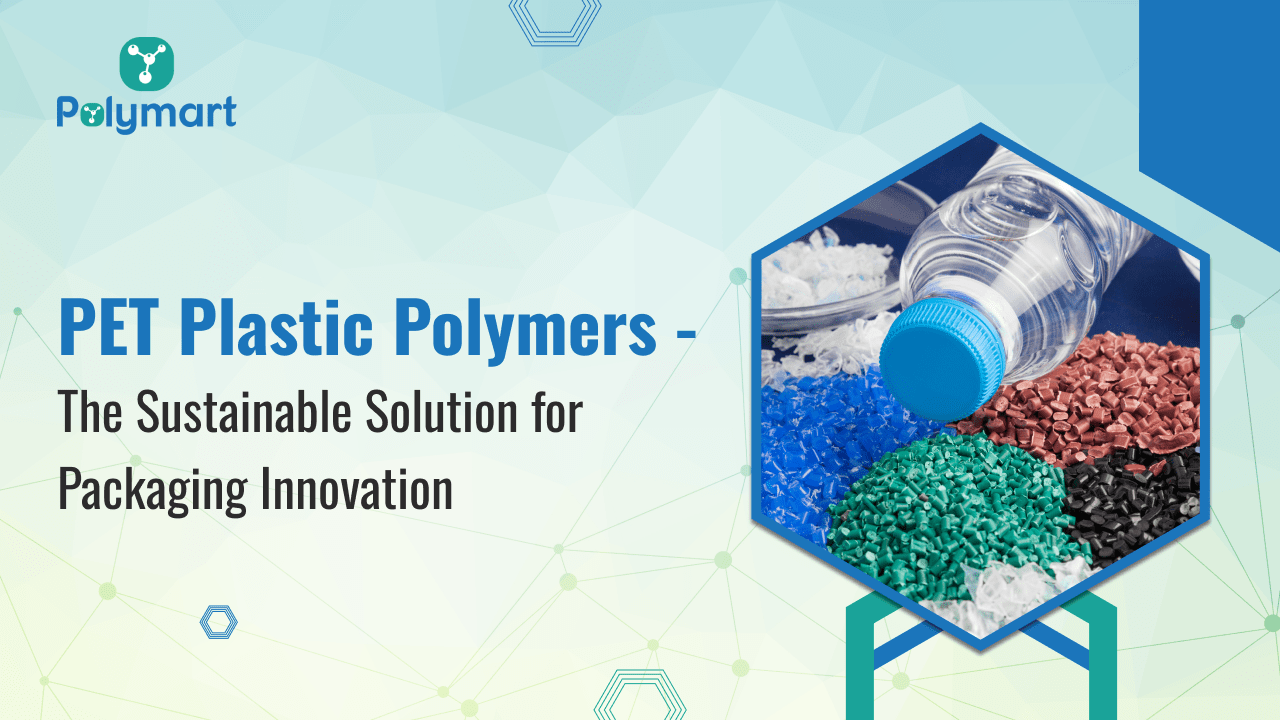
In today’s era, where sustainability and versatility are paramount, PET plastic polymers emerge as a solution that ticks all the right boxes. From packaging to textiles, PET offers a plethora of applications backed by its exceptional properties. But what is PET and why does it stand out as a must-buy polymer for food packaging applications?
In this blog, we will look at the fundamentals of PET plastic polymers, including their composition, properties, and various applications across industries. So, without further ado, read on!
What is PET Plastic Polymer?
PET/PETE, or Polyethylene Terephthalate, is a type of thermoplastic polymer resin that is widely used in various industries. It belongs to the family of polyesters known for having a semi-crystalline form when stable. PET polymers are made through a process of extruding polyethylene and terephthalic acid, forming a long chain of repeating units. Because of its lightweight nature and ability to be recycled, PET has become increasingly popular as an environmentally friendly packaging solution.
What are the Properties of PET Plastic Polymers?
PET, or Polyethylene Terephthalate, provides a remarkable set of properties that make it suitable for various applications. Have a quick look at the properties of PET plastic!
Exceptional Transparency: PET exhibits remarkable clarity, making it ideal for applications where visibility of contents is paramount, such as in beverage bottles and food packaging.
Incredible Strength: PET is renowned for its high tensile strength, providing exceptional durability and resistance to deformation even under stress. This property makes it ideal for applications requiring robust materials.
Lightweight Design: Despite its strength, PET is lightweight, contributing to its suitability for packaging applications. Its lightweight nature reduces transportation costs and environmental impact.
Chemical Resistance: PET demonstrates outstanding resistance to a wide range of chemicals, including acids and alkalis, enhancing its versatility in various industrial settings.
Superior Barrier Properties: PET offers excellent barrier properties against moisture, gases, and odours, ensuring the integrity and freshness of packaged products over time.
Recyclability: One of PET’s most significant advantages is its recyclability. It can be easily recycled into new products, contributing to the circular economy and reducing environmental impact.
Versatility: PET is a remarkably versatile material that can be processed through various manufacturing techniques, including injection molding, blowing, and extrusion. This versatility allows for the production of a wide range of products.
What are the Uses of PET Plastic Polymers?
PET plastic polymers find extensive applications across a wide range of industries because of their versatile properties. Some of the key applications and uses of PET include:
Versatile Packaging Solutions: PET is used for bottles, containers, and films, providing clarity and superior barrier properties.
Durable Textile Production: Polyester fibers derived from PET are renowned for their strength and versatility in clothing, upholstery, and carpets.
Eco-Friendly Beverage Packaging: PET bottles are lightweight and recyclable, making them the top choice for water, soft drinks, and juices.
Hygienic Medical Devices: PET’s biocompatibility makes it ideal for syringes, IV bags, and surgical instruments.
Preserving Food Freshness: PET ensures the freshness and quality of packaged food items, making it a staple in the food packaging industry.
An Overview Look at PET Plastic Polymers:
| Aspect | Details |
| Chemical Formula | C10H8O4 |
| Melting Point | 250-260°C (482-500°F) |
| Density | 1.38-1.39 g/cm³ |
| Transparency | High clarity and transparency |
| Tensile Strength | High tensile strength |
| Flexural Modulus | 2.5-3.5 GPa (363-508 ksi) |
| Thermal Conductivity | 0.15-0.24 W/(m·K) |
| Specific Heat Capacity | 1.0-1.3 J/(g·K) |
| Coefficient of Thermal Expansion | 70-80 x 10^-6 /°C (39-44 x 10^-6 /°F) |
| Water Absorption | < 0.7% (24 hours, at 23°C) |
| Gas Permeability | Low permeability to gases |
| UV Resistance | Good resistance to UV radiation |
| Chemical Resistance | Resistant to acids, alkalis, and many organic solvents |
| Recyclability | Highly recyclable |
| Resin Code | #1 |
| Common Applications | Bottles, containers, fibers, textiles, packaging |
How to Recycle PETE or PET Plastic?
Here’s a simple guide on how to recycle PET plastic effectively:
- To find PET materials, look for the recycled code icon behind the packets.
- Sort PET materials from other recyclables.
- Ensure PET items are clean and free from contaminants.
- Locate nearby recycling centers or drop-off points that accept PET plastics.
- Take cleaned PET materials to designated recycling centers.
- Flatten PET containers to maximize space efficiency.
- Spread awareness about PET recycling and encourage others to participate.
How to Buy & Sell PET Plastic Polymers
Looking to buy or sell PET plastic polymers? With the increasing demand for sustainable packaging solutions, PET plastic polymers have become a sought-after material in various industries.
As a leading polymer distribution company in India, we are here to ease the polymer procurement process. For a seamless buying and selling experience, consider using the Polymart app, a dedicated platform connecting buyers and sellers in the polymer industry. Install the app today!